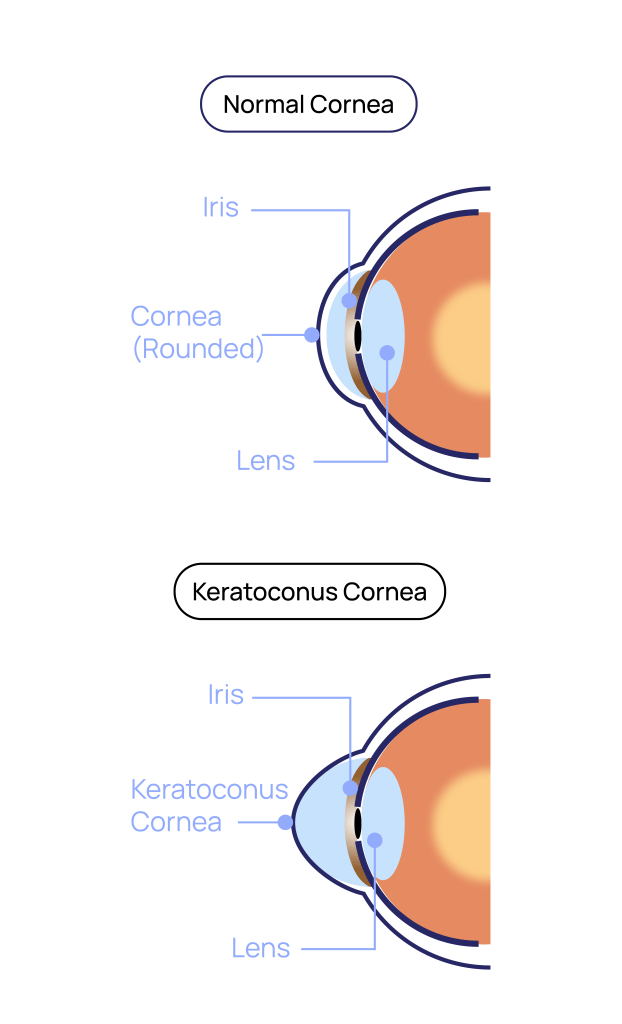
Early intervention is crucial for effectively managing this condition. Moreover, specialized contact lenses can help stabilize the condition and preserve vision, while also contributing to better long-term visual outcomes and ultimately improving the overall quality of life.
At St. Lucia Eye Center, our eye specialists provide advanced solutions tailored to improve vision. In addition, these treatments offer enhanced comfort and clarity for individuals with keratoconus.

Keratoconus is a progressive condition in which the cornea thins and bulges outward into a cone-like shape. This irregular shape distorts light entering the eye, leading to blurry vision, double vision, or light sensitivity.
Rigid gas-permeable lenses help correct vision by providing a smooth surface for light to pass through, in order to improve clarity for individuals with keratoconus.
Scleral lenses are specialized contact lenses that rest on the white part of the eye, creating a smooth surface over the irregular cornea. These lenses offer comfort and vision clarity for advanced cases.
Although the exact cause of keratoconus isn’t fully understood, several factors may contribute to its development, including:
Keratoconus can be hereditary, often affecting individuals who have a family history of the condition.
Rubbing the eyes frequently or aggressively can damage the cornea and contribute to the development of keratoconus.
Exposure to irritants, pollutants, or allergies can occasionally exacerbate the symptoms or progression of keratoconus.
Conditions such as Down syndrome, Ehlers-Danlos syndrome, and Marfan syndrome are associated with an increased risk of developing keratoconus.
Hormonal fluctuations, especially during puberty, can actively influence the progression of keratoconus.
Infections or injuries to the cornea can contribute to the weakening and thinning of the cornea, increasing the risk of developing keratoconus.
Regular eye exams are crucial, especially for individuals with a family history of keratoconus or symptoms of visual distortion. Timely intervention can prevent further progression and significantly preserve vision.
Keratoconus is diagnosed through comprehensive eye exams, including corneal topography. Treatment options range from glasses and soft lenses in early stages to specialized contact lenses eventually.
A combination of visual tests, corneal imaging, and topography is used to assess the shape and thickness of the cornea.
A specialized imaging test creates a detailed map of the cornea’s shape, allowing for the detection of irregularities.
A specialized microscope closely examines the cornea, helping detect early signs of keratoconus and other potential issues.
Diagnosis involves thorough testing to map the shape and thickness of the cornea. Furthermore, early intervention plays a key role in preventing the condition from worsening and preserving vision.


These lenses offer clearer vision and help create a smooth optical surface, subsequently improving vision quality.
Specialized lenses designed to vault over the cornea, creating a new surface that improves vision and provides comfort.
A one-time procedure that strengthens the cornea and prevents it from getting worse in addition to improving current vision.
Treatment becomes necessary if you experience distorted vision, frequent prescription changes, or other symptoms. Additionally, early intervention can help prevent further progression and preserve your vision.
Early diagnosis and timely treatment can stabilize the condition, as a result improve visual outcomes.
Depending on the severity of your condition, you may struggle with driving at night or in low-light conditions.
Regular follow-up visits are essential to monitor the condition's progression and adjust treatment plans accordingly.
This condition can affect individuals differently, but early intervention and regular monitoring can significantly improve quality of life and visual function.
If you have a family history of keratoconus, regular eye exams are essential to detect the condition early.
Many individuals can successfully manage the condition with specialized lenses, often eliminating the need for surgery.
Keratoconus is a progressive condition that may worsen over time. However, early treatment can help slow its progression and preserve vision for longer.
Ready to see the world more clearly? Call us today or book an appointment online. Our bilingual team is ready to assist you in Spanish or English.
Sign up for our newsletter to find out about our latest news and promotions.